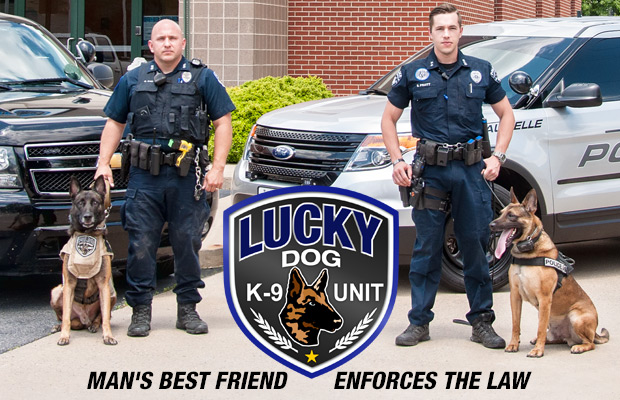Lucky Dog

We have all seen the police vehicles with the words K-9 prominently displayed. Maybe you’ve seen a movie or television show where a trusty police dog raced in and saved the day at the last possible moment. But very few if us know much about these hard-working dogs, and just how special their skills are. At first blush, we may even think that they have really lucked out with their impressive jobs and caring police partners. But is that really the case for these lucky dogs?
Belgian Malinois is the name of the standard breed for law enforcement work dogs. They are imported from Europe, typically from Hungary, the Netherlands, Germany and the Czech Republic and cost around $10,000.00. The reason the dogs are imported is because the Europeans have a breeding board with very high standards and strict regulations as well as a set operating procedure, and it makes the investment more solid for American law enforcement agencies.
Sterling Pruitt has been a police officer for four years, and a K-9 cop for three years, working with his assigned K-9 partner Bodie that whole time. Sterling has strong ties to Saline County, as his father is Doug Pruitt, pastor of Midtowne Church in Benton. “I don’t ever see myself as a cop without a dog. We are always learning new things, and it’s a lot of fun,” says Sterling.
Mark Kling of the Bryant Police Department has been an officer for seven years, four of which have been with a K-9. His dog is named Stubby, and says “the best part of being a K-9 cop is having a partner with you at all times. It’s so nice to have the back-up and camaraderie with Stubby.”
Working police dogs usually come to the US when they are 12-18 months old, then complete training school with their assigned officer, and obedience training continues throughout the dog’s career. According to Sterling, “obedience training is priority one, and we work on that every day.”
What most people probably don’t realize that English is not used in the every day life of these working dogs. The working dog commands used for Bodie are Hungarian, and Dutch for Stubby, as those are the native languages they were trained with.
Police dogs live with their officer at their home, and stick to a consistent daily routine. Says Mark “It’s up to us to keep the dog in a work state of mind, even at home. We have to give them purpose and a reason to want to work, and that’s part of the daily routine. Every day Stubby races to the truck and patiently waits for me. He’s alert and ready.”
Patrol dogs typically have four tasks they are trained in. The first is the ability to track people using their sense of smell. The second is article recovery. An example of article recovery is the ability to match the smell of an item from a specific search area to the smell from a particular car, thus identifying an item from that car. The third task is the ability to smell narcotics such as marijuana, methamphetamines, cocaine and heroin. The fourth and final task patrol dogs are trained for is apprehension and defense.
Sterling shares, “A patrol dog’s sense of smell is five thousand times stronger than that of a human, and can smell drugs, drug paraphernalia, and even residue left behind hours after the substance has been removed. When a patrol dog finds a scent like marijuana or cocaine, they are trained to display a passive alert, which means he’ll lay down or sit where he sniffs an odor.”
The apprehension and defense part of a patrol dog’s job description is one that most people probably aren’t aware of. To begin with, when a patrol dog apprehends a target, he will latch on to people. It’s not an aggressive maul or bite, it’s a bite-hold that he’s trained to hold onto until the officer arrives.
In terms of defense, all K-9 officers have a control button on their belt that controls the back door of their patrol vehicle. If the officer opens the back door of the vehicle from the control on the belt, the dog is trained to immediately go look for the officer. The device also has a car temperature alert and will let the officer know if the car is too warm for the dog. The device allows the officer to start the car and cool it down, thus giving it the name “hot dog alert.”
Working police dogs look at their duties as a game. “A police dog considers his job play. He looks for rewards in all he does, and for Bodie that reward is typically praise and a tennis ball,” shares Sterling.
From a personality standpoint, patrol dogs are very social. They regularly visit day cares and elementary schools with their patrol officers as part of their duties, and the dogs typically thrive in these environments.
The average career of a patrol dog is seven to eight years. Sterling is quick to add how important it is for officers to remain aware that K-9s are a tool for the police department. “Although I love Bodie, he’s a tool for me as I do my job. He has a specific purpose for the police department.” Mark agrees, and shares “One of the public’s biggest misconceptions is that these dogs are ordinary. As a canine officer, we let our dogs be dogs and play with them, but they are considered officers, not pets.”
It’s safe to say that after talking with officers like Mark and Sterling, its crystal clear that they view themselves as the ones benefitting from their loyal, trusted partners Bodie and Stubby. Maybe from now on when you drive past a police vehicle with the letters K-9 emblazoned on it, or see a movie with a heroic dog, you’ll look at their commanding officer and think of them as the lucky one.









0 comments